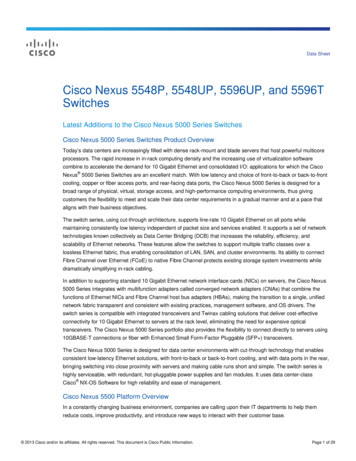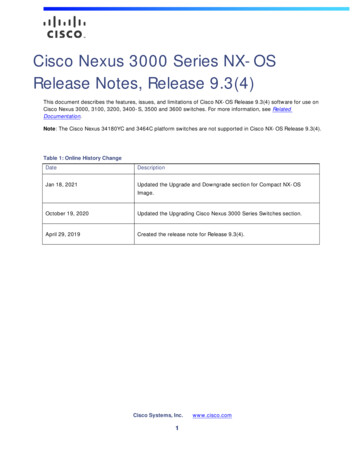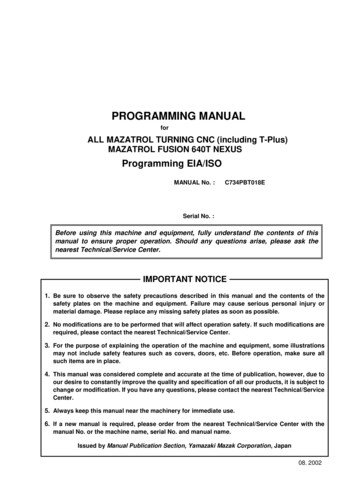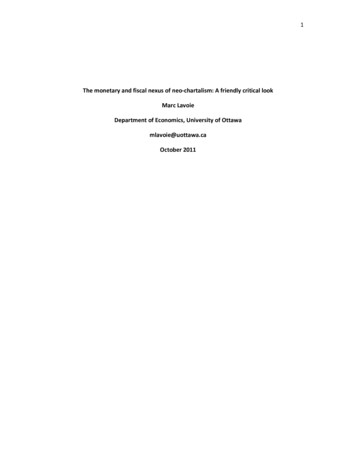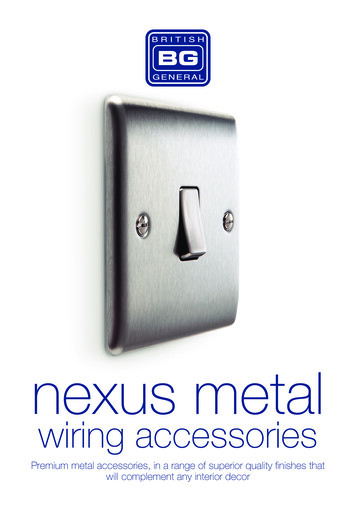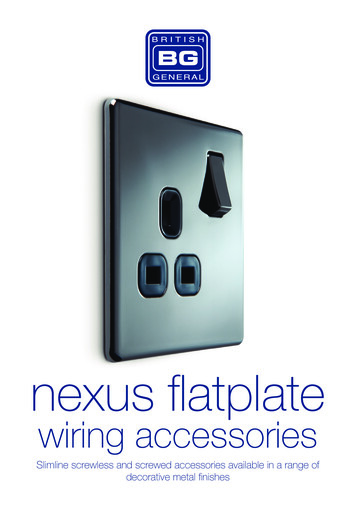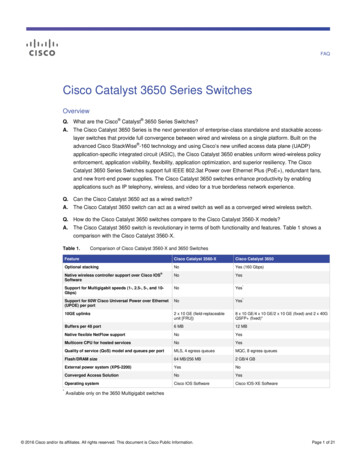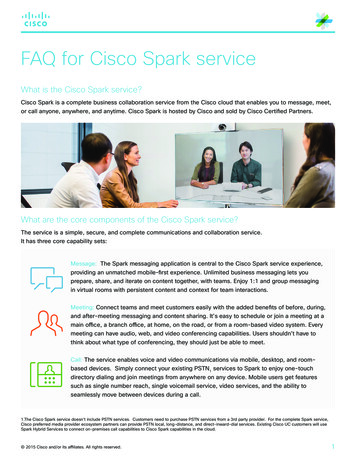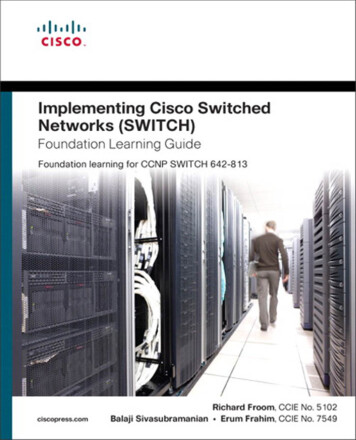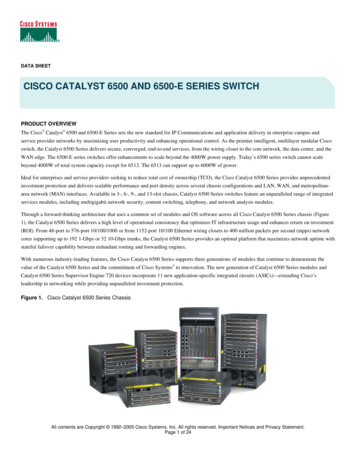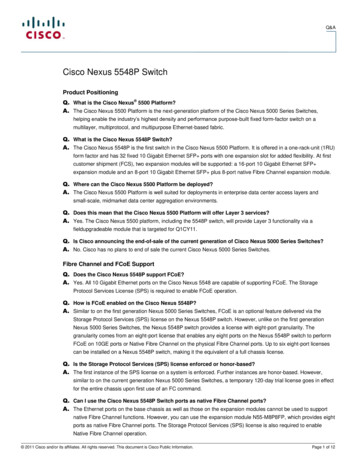
Transcription
Q&ACisco Nexus 5548P SwitchProduct PositioningQ. What is the Cisco Nexus 5500 Platform?A. The Cisco Nexus 5500 Platform is the next-generation platform of the Cisco Nexus 5000 Series Switches,helping enable the industry’s highest density and performance purpose-built fixed form-factor switch on amultilayer, multiprotocol, and multipurpose Ethernet-based fabric.Q. What is the Cisco Nexus 5548P Switch?A. The Cisco Nexus 5548P is the first switch in the Cisco Nexus 5500 Platform. It is offered in a one-rack-unit (1RU)form factor and has 32 fixed 10 Gigabit Ethernet SFP ports with one expansion slot for added flexibility. At firstcustomer shipment (FCS), two expansion modules will be supported: a 16-port 10 Gigabit Ethernet SFP expansion module and an 8-port 10 Gigabit Ethernet SFP plus 8-port native Fibre Channel expansion module.Q. Where can the Cisco Nexus 5500 Platform be deployed?A. The Cisco Nexus 5500 Platform is well suited for deployments in enterprise data center access layers andsmall-scale, midmarket data center aggregation environments.Q. Does this mean that the Cisco Nexus 5500 Platform will offer Layer 3 services?A. Yes. The Cisco Nexus 5500 platform, including the 5548P switch, will provide Layer 3 functionality via afieldupgradeable module that is targeted for Q1CY11.Q. Is Cisco announcing the end-of-sale of the current generation of Cisco Nexus 5000 Series Switches?A. No. Cisco has no plans to end of sale the current Cisco Nexus 5000 Series Switches.Fibre Channel and FCoE SupportQ. Does the Cisco Nexus 5548P support FCoE?A. Yes. All 10 Gigabit Ethernet ports on the Cisco Nexus 5548 are capable of supporting FCoE. The StorageProtocol Services License (SPS) is required to enable FCoE operation.Q. How is FCoE enabled on the Cisco Nexus 5548P?A. Similar to on the first generation Nexus 5000 Series Switches, FCoE is an optional feature delivered via theStorage Protocol Services (SPS) license on the Nexus 5548P switch. However, unlike on the first generationNexus 5000 Series Switches, the Nexus 5548P switch provides a license with eight-port granularity. Thegranularity comes from an eight-port license that enables any eight ports on the Nexus 5548P switch to performFCoE on 10GE ports or Native Fibre Channel on the physical Fibre Channel ports. Up to six eight-port licensescan be installed on a Nexus 5548P switch, making it the equivalent of a full chassis license.Q. Is the Storage Protocol Services (SPS) license enforced or honor-based?A. The first instance of the SPS license on a system is enforced. Further instances are honor-based. However,similar to on the current generation Nexus 5000 Series Switches, a temporary 120-day trial license goes in effectfor the entire chassis upon first use of an FC command.Q. Can I use the Cisco Nexus 5548P Switch ports as native Fibre Channel ports?A. The Ethernet ports on the base chassis as well as those on the expansion modules cannot be used to supportnative Fibre Channel functions. However, you can use the expansion module N55-M8P8FP, which provides eightports as native Fibre Channel ports. The Storage Protocol Services (SPS) license is also required to enableNative Fibre Channel operation. 2011 Cisco and/or its affiliates. All rights reserved. This document is Cisco Public Information.Page 1 of 12
Q&AQ. Does the Cisco Nexus 5548P support FCoE VE port (Virtual E port)?A. Yes, the Cisco Nexus 5548P supports VE-to-VE connectivity on directly connected Data Center Bridging (DCB)capable links. This feature will be released for Nexus 5548 first and prior N5Ks in a later release.Q. What is Unified Ports?A. Unified Ports combine the physical layer port functionality of 1 Gigabit Ethernet, 10 Gigabit Ethernet, and8/4/2/1G Fibre Channel onto a physical port. The physical port can be configured as 1/10G Traditional Ethernet,10G Fibre Channel over Ethernet, or 8/4/2/1G Native Fibre Channel. The Storage Protocol Services (SPS)license is required to enable the use of both FCoE and Native FC operations on the Unified Ports.Q. When will Unified Ports be available on the Cisco Nexus 5548P?A. On the Nexus 5548P, 16 Unified Ports will be offered via an expansion module targeted for Q1CY11.Hardware and EnvironmentQ. What are the main technical benefits of the Cisco Nexus 5548P compared to the previous generation ofthe Cisco Nexus 5000 Series Switches?A. The main technical benefits include: Higher port density: The Cisco Nexus 5548 can support up to 48 10 Gigabit Ethernet with a 16-port 10 GigabitEthernet expansion module in a single 1RU form factor. Lower-latency cut-through switching: Latency is reduced to about 2 microseconds. Better scalability: VLAN, MAC address count, Internet Group Management Protocol (IGMP) group,PortChannel, ternary content addressable memory (TCAM), Switched-Port Analyzer (SPAN) session, andlogical interface (LIF) count scalability are increased. Hardware support for Cisco FabricPath and standards-based Transparent Interconnection of Lots of Links(TRILL): This support makes the Cisco Nexus 5500 Platform an excellent platform for building large-scale,loop-free Layer 2 networks. Support for ingress and egress differentiated services code point (DSCP) marking. Layer 3 support: A field-upgradable routing card will be available in the future. Enhanced SPAN implementation: This feature protects data traffic in case of congestion resulting from SPAN.It enables more active SPAN sessions and supports fabric extender ports as SPAN destinations.Q. What is the architecture of Cisco Nexus 5548P?A. The Cisco Nexus 5548P implements a switch-fabric-based architecture. It consists of a set of port applicationspecific interface cards (ASICs) called unified port controllers (UPCs) and a switch fabric called the unified fabriccontroller (UFC). The UPCs provide packet-editing, forwarding, quality-of-service (QoS), security-table-lookup,buffering, and queuing functions. The UFC connects the ingress UPCs to the egress UPCs and has a built-incentral scheduler. The UFC also replicates packets for unknown unicast, multicast, and broadcast traffic. EachUPC supports eight 1 and 10 Gigabit Ethernet interfaces; however, no local switching is performed on the UPCs.All packets go through the same forwarding path, and the system helps ensure consistent latency for all flows.Q. Does the Cisco Nexus 5548P support Cisco FabricPath?A. Yes. The Cisco Nexus 5548P hardware supports Cisco FabricPath, which will be enabled in a future softwarerelease.Q. Does the Cisco Nexus 5548P support IETF TRILL?A. Yes. The Cisco Nexus 5548P hardware supports prestandard IETF TRILL, since TRILL has not been completelystandardized. Support will therefore be enabled in a future software release. 2011 Cisco and/or its affiliates. All rights reserved. This document is Cisco Public Information.Page 2 of 12
Q&AQ. Does the Cisco Nexus 5548P support Layer 3 routing?A. Yes. The Cisco Nexus 5500 Platform has been designed with Layer 3 support from the start. At FCS, Layer 3routing will not be available on the Cisco Nexus 5548P and will be enabled in the near future through afieldupgradeable daughter card.Q. What are considered the front and back of a Cisco Nexus 5548P Switch?A. The front of the Cisco Nexus 5548P is where the fans, power supplies, and management ports are located. Theback of the Cisco Nexus 5548 is where the fixed Ethernet data ports and the expansion slot are located. Thedata ports are located on the back of the Cisco Nexus 5548P to facilitate cabling with servers.Q. Do the power supplies on the Cisco Nexus 5548P support both 110 and 220-volt (V) inputs?A. Yes. The supported voltage range is from 100V to 240V.Q. What are the additional RJ45 ports next to the management interface on the front of the Cisco Nexus5548P?A. The additional front panel RJ-45 ports are designed for future use. At present, the Cisco Nexus 5548P supportsonly a single out-of-band management interface.Q. Can the existing expansion modules on the Cisco Nexus 5010 and 5020 Switches be used on the CiscoNexus 5500 Platform?A. No. The expansion modules supported on the Cisco Nexus 5010 and 5020 are not supported on the CiscoNexus 5500 Platform.Q. Can the existing power supplies and fan modules on the Cisco Nexus 5010 and 5020 be used on theCisco Nexus 5500 Platform?A. No. The power supplies and fan modules for the Cisco Nexus 5010 and 5020 are not interchangeable with thoseon the Cisco Nexus 5500 Platform.Q. Does the Cisco Nexus 5548P run the same software image as the Cisco Nexus 5010 and 5020 Switches?A. Yes. All Cisco Nexus 5000 Series Switches, including the Cisco Nexus 5500 Platform, support the samesoftware image.Q. Does the Cisco Nexus 5548P support a USB interface?A. Yes. There is one type-A USB interface on the front of the Cisco Nexus 5548P.Q. What kind of CPU is used on Cisco Nexus 5548?A. Intel Dual-Core 1.73GHz with 2 memory channels, DDR3 at 1066Mhz, with 4MB cache.Q. How much CPU memory comes with the Cisco Nexus 5548P?A. The Cisco Nexus 5548P comes with 8 GB of CPU DRAM.Q. How much flash memory comes with the Cisco Nexus 5548P?A. The Cisco Nexus 5548P comes with 2 GB of flash memory.Q. What are the typical and maximum power consumption amounts for the Cisco Nexus 5548P?A. The typical power consumption of the Cisco Nexus 5548P is 390 watts (W), and the maximum powerconsumption is 600W.Q. Does the Cisco Nexus 5548P support 1 Gigabit Ethernet ports?A. All Ethernet ports on the Cisco Nexus 5548P, including the Ethernet ports on expansion modules, are hardwarecapable of supporting both 1 and 10 Gigabit Ethernet speeds. Software support for 1 Gigabit Ethernet will beavailable in a future software release. 2011 Cisco and/or its affiliates. All rights reserved. This document is Cisco Public Information.Page 3 of 12
Q&AQ. What types of transceivers are supported by the Cisco Nexus 5548P?A. Please refer to the Cisco Nexus 5500 Platform data sheet for a list of supported transceivers and cable types.Data sheets and associated collateral can be found at http://www.cisco.com/go/nexus5000.Q. Does the Cisco Nexus 5548P support IEEE 802.1ae link-level cryptography?A. No. The Cisco Nexus 5548P Switch hardware does not support IEEE 802.1ae.Hardware Performance and ScalabilityQ. What is the performance throughput of the Cisco Nexus 5548P?A. The Cisco Nexus 5548P provides up to 960-Gbps throughput. It implements a nonblocking hardware architectureand helps achieve a line-rate throughput for all frame sizes, for both unicast and multicast traffic, across all ports.Q. Should I expect any performance degradation when I turn on some features, such as access control lists(ACLs) and Fibre Channel over Ethernet (FCoE), on the Cisco Nexus 5548P?A. All ports on the Cisco Nexus 5548P provide line-rate performance regardless of the features that are turned on.Q. The Cisco Nexus 5548P implements cut-through switching among all its 10 Gigabit Ethernet ports. Doesit also support cut-through switching for all 1 Gigabit Ethernet, native Fibre Channel, and FCoE ports?A. Under various circumstances, the Cisco Nexus 5548P can act as either a cut-through switch or a store-andforward switch. Table 1 summarizes the switch behavior in various scenarios.Table 1.Switching ModeSource InterfaceDestination InterfaceSwitching Mode10 Gigabit Ethernet10 Gigabit EthernetCut-through10 Gigabit Ethernet1 Gigabit EthernetCut-through1 Gigabit Ethernet1 Gigabit EthernetStore-and-forward1 Gigabit Ethernet10 Gigabit EthernetStore-and-forwardFcoEFibre ChannelCut-throughFibre ChannelFCoEStore-and-forwardFibre ChannelFibre r the ingress interface operates at 10 Gigabit Ethernet speed, cut-through switching is used.Q. How many MAC addresses does the Cisco Nexus 5548P support?A. The Cisco Nexus 5548P Switch hardware provides an address table for 32,000 MAC addresses. The same MACaddress table is shared between unicast and multicast traffic, and it also includes some internal entries. At FCS,4000 MAC address entries will be reserved for multicast groups that are learned through IGMP snooping, and25,000 MAC address entries will be reserved for unicast traffic. The remaining 3000 MAC address entries will beused to handle hash collision.Q. How many VLANs does the Cisco Nexus 5548P support?A. The Cisco Nexus 5548P supports up to 4094 active VLANs. Of these, a few are reserved for internal use, thusproviding users with up to 4014 configurable VLANs.Q. How many PortChannels are supported with the Cisco Nexus 5548P?A. All ports on the Cisco Nexus 5548P can be configured as PortChannel members. The Cisco Nexus 5548PSwitch hardware can support up to 48 local PortChannels and up to 576 PortChannels on the host-facing portsof Cisco Nexus 2000 Series Fabric Extenders.Q. How many ports can be in a PortChannel on the Cisco Nexus 5548P?A. One PortChannel can have up to 16 members on the Cisco Nexus 5548P. 2011 Cisco and/or its affiliates. All rights reserved. This document is Cisco Public Information.Page 4 of 12
Q&AQ. What is the TCAM table size on the Cisco Nexus 5548P?A. The Cisco Nexus 5548P provides a 4000-TCAM table size; however, the table is shared among port ACLs,VLAN ACLs, QoS ACLs, SPAN ACLs, and ACLs for control traffic redirection.Q. How many Spanning Tree Protocol logical ports are supported on the Cisco Nexus 5548P?A. The Cisco Nexus 5548P supports up to 12,000 logical ports, of which up to 4000 can be network ports forswitch-to-switch connection.Fabric Extender SupportQ. Can the Cisco Nexus 2000 Series Fabric Extenders connect to the expansion module ports on the CiscoNexus 5548P?A. Yes. The Cisco Nexus 2000 Series Fabric Extenders can connect to any Ethernet port on the Cisco Nexus5548P.Q. How many Cisco Nexus 2000 Series Fabric Extenders can connect to a single Cisco Nexus 5548PSwitch?A. At FCS, one Cisco Nexus 5548P will support up to 12 Cisco Nexus 2000 Series Fabric Extenders. The scalabilitywill increase with future software releases.Q. Does the Cisco Nexus 5548P support all the currently available Cisco Nexus 2000 Series FabricExtenders?A. Yes. The Cisco Nexus 5548P supports all four currently available Cisco Nexus 2000 Series Fabric Extenders:Cisco Nexus 2148T, 2248TP GE, 2224TP GE, and 2232PP 10GE Fabric Extenders.Management and TroubleshootingQ. Does the Cisco Nexus 5548P Switch hardware support NetFlow?A. No. The Cisco Nexus 5548P Switch hardware does not support NetFlow.Q. How many SPAN sessions does the Cisco Nexus 5548P support?A. The Cisco Nexus 5548P supports up to four active SPAN sessions.Q. Does SPAN traffic affect the data traffic on the Cisco Nexus 5548P?A. No. The Cisco Nexus 5548P Switch hardware is designed to give higher priority to data traffic during periods ofcongestion when both SPAN and data traffic could contend with each other. When such congestion occurs, theCisco Nexus 5548P can easily be configured to protect the higher-priority data traffic while dropping the lowerpriority SPAN traffic.Q. Can a 1 Gigabit Ethernet port on the Cisco Nexus 5548P be configured as a SPAN destination port?A. Yes. After 1 Gigabit Ethernet mode is software enabled on the Cisco Nexus 5548P, any 1 Gigabit Ethernet portcan be configured as a SPAN destination port.Q. Can I use SPAN to capture a Priority Flow Control (PFC) frame on the Cisco Nexus 5548P?A. No. The PFC frame will not be mirrored from the SPAN source port to the SPAN destination port.Q. Can a Cisco Nexus 2000 Series host-facing port be configured as a SPAN destination port on the CiscoNexus 5548P?A. The Cisco Nexus 5548P Switch hardware supports configuration of Cisco Nexus 2000 Series host-facing portsas SPAN destination ports. However, the software support will be available in a future release. 2011 Cisco and/or its affiliates. All rights reserved. This document is Cisco Public Information.Page 5 of 12
Q&AQ. Does the Cisco Nexus 5548P support Encapsulated Remote SPAN (ERSPAN)?A. In a post-FCS software release, the Cisco Nexus 5548P will support ERSPAN source sessions. The CiscoNexus 5548P cannot de-encapsulate ERSPAN packets and therefore will not support ERSPAN destinationsessions.Q. Does the Cisco Nexus 5548P support RSPAN?A. No. The Cisco Nexus 5548P does not support RSPAN.Q. Does the Cisco Nexus 5548P support the IEEE 1588 Precision Time Protocol (PTP) feature?A. The Cisco Nexus 5548P Switch hardware is capable of supporting IEEE 15888 PTP. However, software supportwill be available in a future software release.Q. Do the Cisco Data Center Network Manager (DCNM) and Cisco Fabric Manager support the Cisco Nexus5548P?A. Cisco DCNM and Cisco Fabric Manager support for the Cisco Nexus 5548P will be available 2 to 3 monthsafter FCS.Configuration SynchronizationQ. What is the configuration synchronization feature introduced in Cisco NX-OS Release 5.0(2)N1(1) for theCisco Nexus 5000 Series?A. Configuration synchronization (config-sync), when enabled, allows the configuration made on one switch to bepushed to another switch through software. The feature is mainly used in virtual PortChannel (vPC) scenarios toeliminate the manual configuration on both vPC peer switches. It also eliminates the possibility of human errorand helps ensure that both switches have the exact same configuration.Q. Does config-sync require special hardware?A. Config-sync is a software feature that is hardware independent. Starting with Cisco NX-OS Release 5.0(2)N1(1),it is supported on all Cisco Nexus 5000 Series Switches, including the Cisco Nexus 5548P.Q. Can Type 1 and Type 2 inconsistencies be avoided with config-sync?A. No. vPC and config-sync are two separate features. For vPC to be operational, Type 1 and Type 2 parametersmust match. If the parameters do not match, users will continue to experience a vPC-failure scenario. Configsyncallows the user to make changes on one switch and synchronize the configuration with that on the other peerautomatically. It saves the user from having to create identical configurations on each switch.Q. What are the three requirements for enabling the config-sync feature?A. To enable the config-sync feature, users need to: Enable Cisco Fabric Services over IP on each peer Create identical switch profiles on each switch Configure the correct peer IP addressesQ. Which interface carries config-sync traffic?A. Config-sync messages are carried only over the mgmt0 interface. They cannot currently be carried over the inband switch virtual interfaces (SVIs).Q. If I use a direct point-to-point connection using SVIs and the default Virtual Routing and Forwarding(VRF) instance for my peer keepalive (instead of the mgmt0 interface and the management VRFinstance), will config-sync work?A. Config-sync is independent of vPC. As long as users have mgmt0 connectivity and can reach the vPC peer,config-sync will work. 2011 Cisco and/or its affiliates. All rights reserved. This document is Cisco Public Information.Page 6 of 12
Q&AQ. When config-sync is implemented, why are VLANs not propagated?A. Users must make sure that the specific features are enabled on each Cisco Nexus 5548P Switch. Features arenot automatically synchronized.Q. Is FCoE supported under config-sync?A. No. FCoE is not supported under config-sync. The supported features for a switch profile are VLANs, ACLs,Spanning Tree Protocol, QoS, and interface-level configurations (Ethernet, PortChannels, and vPC).Q. What happens if the commit process fails during a config-sync operation?A. The configuration will be rolled back to the original (default) state, resulting in no configuration changes. Neitherswitch will update any configurations.Q. What happens if the switch profile has been created but no commit command was entered, yet a reloadoccurs?A. In this instance, the switch profile was not saved to the startup configuration, and as a result, no changes will bemade.Q. If the peer is lost (config-sync transport is down) and local configuration changes are made on oneswitch, what h
The Cisco Nexus 5500 Platform is the next-generation platform of the Cisco Nexus 5000 Series Switches, helping enable the industry’s highest density and performance purpose-built fixed form-factor switch on a multilayer,
